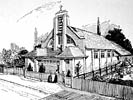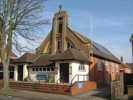For this church:    |
|
 The church between The church between1901 and 1906 |
 The church after 1906 The church after 1906 |
By 1901 the iron church was proving inadequate to house the rapidly growing congregation and by the end of the year a brick extension had been added. The Nottingham Evening Post provides details of the building added to the original iron church:
'[It] consisted of a nave, 36ft. long by 28ft wide, and a chancel 18ft. long by 28ft placed at the east end, giving a total length of 90ft. The new building was a neat and comfortable structure of red brick with stone facings and was erected in 1901 at a cost of £600.'
The church was further extended westward to Pierrepont Road in 1906. The Nottingham Evening Post, reporting on the opening of the enlarged church by the Bishop of Southwell on 9 November, describes the work undertaken:
'The iron portion of the old mission church has been taken away, and the stone building has been extended towards the road, giving a room, exclusive of the chancel and entrance, 70 foot long and 28 feet wide, with seating accommodation for 500 people.'
In 1914, it was noted that its working arrangements were under the direction and supervision of the Rector of West Bridgford. There was a large Sunday School and Band of Hope still. In 1902 there were 116 members of the Band of Hope.
The church had an active social life with a number of affiliated clubs and societies. A ladies working party was formed in 1914 to knit comforts for the troops. The party continued to labour for the work of the church after the war had ended.
A men’s club was set up in 1946 and there were flourishing scout and guide groups.
The church was dedicated to All Hallow’s on 24 September 1942 and consecrated on 3 December 1950. Before this date it was known simple as Lady Bay Church.
The choice of name references the fact that the adjoining village of Adbolton used to have as its parish church the ancient shrine of All Hallows. As the village became depopulated and the church fell into disrepair (and was eventually pulled down), stone from the earlier building was placed beneath the font at Lady Bay.
In 1945, as a thanks-offering to mark victory and peace in Europe, a hand-beaten silver chalice and paten were made. They took the form of replicas of the vessels at York Minster c.1340. They were dedicated by the Bishop of Southwell on 26 September 1945 and cost £34 to make.
In 1946, arrangements had been made at Mansfield St Lawrence for the institution of the Reverend C. H. B. Watson, then incumbent at Lady Bay. Watson, however, decided at the last minute to stay at All Hallows and withdrew his acceptance of the position at Mansfield.
Until 1950, All Hallow’s remained a daughter parish of St Giles West Bridgford. In 1950, it was consecrated as the parish church for Lady Bay, specifically the area between the river and the Grantham canal west of Adbolton.
The first wedding at the newly consecrated church of All Hallows was held on 22 April 1950 when Rita Radford married Alfred Henry Cooper. Rita was an active member of the youth organisation of the church.
In the 1950s, the church was offered a huge old fashioned pulpit from a storeroom in St James Porchester. Miss Tidswell who lived opposite All Hallows for 70 years allowed this to be set up in her outhouse. It was here that Cecil Roworth worked to transform it before its installation in 1956.
In 1966, the church held a demonstration of how a good choir works for ‘Choristers in Action’. This was given for local clergy and choirmasters and staged by the Royal School of Church Music and Society for Organists.
In 1983, Peter Bailey left as the vicar of All Hallows. He went on to fulfil a new appointment as a full time religious broadcaster for Radio Trent. A cheese and wine night was held in the church hall to say farewell to Peter and his wife, Linda.
In 2000, a new church hall was built with funds from the Lottery Commission. It was officially opened the following year by the Bishop of Southwell. The development cost £330,000.
From 1 January 2006, the parish of Lady Bay was joined with nearby Holme Pierrepont and Adbolton to form the new Benefice of Lady Bay with Holme Pierrepont and Adbolton.
There is an extensive archive of material on the church at Lady Bay collected by Miss L. I. Edwards and housed in the local studies section of the Nottingham Central Library. This includes letters from the vicar, notices, and orders of service.






